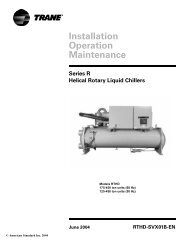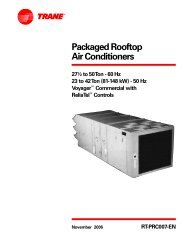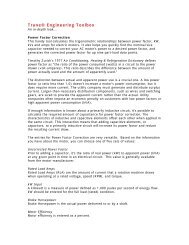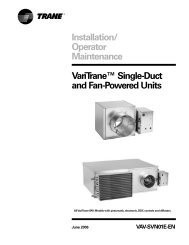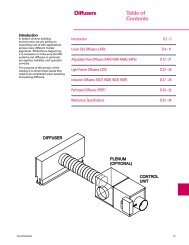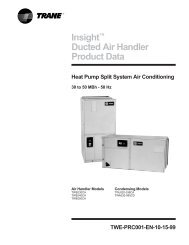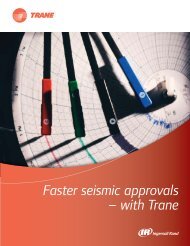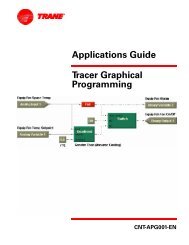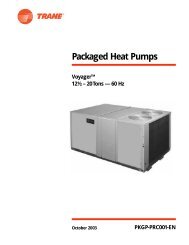Packaged Cooling with Electric Heat Rooftop Units Voyager ... - Trane
Packaged Cooling with Electric Heat Rooftop Units Voyager ... - Trane
Packaged Cooling with Electric Heat Rooftop Units Voyager ... - Trane
You also want an ePaper? Increase the reach of your titles
YUMPU automatically turns print PDFs into web optimized ePapers that Google loves.
Selection<br />
Procedures<br />
<strong>Cooling</strong> Capacity<br />
Step 1<br />
Calculate the building’s total and sensible<br />
cooling loads at design conditions. Use<br />
the <strong>Trane</strong> calculation methods or any<br />
other standard accepted method.<br />
Factors used in unit selection:<br />
A<br />
Total <strong>Cooling</strong> Load: 180 MBh<br />
B<br />
Sensible <strong>Cooling</strong> Load: 129 MBh<br />
C<br />
Airflow: 6000 cfm<br />
D<br />
<strong>Electric</strong>al Characteristics: 460/60/3<br />
E<br />
Summer Design Conditions: Entering<br />
Evaporator Coil: 80 DB, 67 WB Outdoor<br />
Ambient: 95 DB<br />
F<br />
External Static Pressure: 0.49 in. wg<br />
G<br />
<strong>Rooftop</strong> - downflow configuration<br />
H<br />
Accessories<br />
• Roof curb<br />
• Economizer<br />
• <strong>Electric</strong> <strong>Heat</strong><br />
I<br />
<strong>Heat</strong>ing<br />
• Capacity 115 MBh<br />
• 460 volt/3 phase <strong>Electric</strong> <strong>Heat</strong> —at 6000<br />
cfm<br />
Step 2<br />
As a starting point, a rough determination<br />
must be made of the size of the unit. The<br />
final selection will be made after<br />
examining the performance at the given<br />
conditions. Divide the total cooling load by<br />
nominal BTUH per ton (12 MBh per ton);<br />
then round up to the nearest unit size.<br />
180 MBh / 12 MBh = 15.0 Tons<br />
Step 3<br />
Table PD - 2 shows that a TCD180B4 has a<br />
gross cooling capacity of 184 MBh and<br />
130 MBh sensible capacity at 6000 cfm<br />
and 95 DB outdoor ambient <strong>with</strong> 80 DB,<br />
67 WB air entering the evaporator.<br />
To Find Capacity at Intermediate<br />
Conditions Not in the Table<br />
When the design conditions are between<br />
two numbers that are in the capacity<br />
table, interpolation is required to<br />
approximate the capacity. Note:<br />
Extrapolation outside of the table<br />
conditions is not recommended.<br />
Step 4<br />
In order to select the correct unit which<br />
meets the building’s requirements, the<br />
fan motor heat must be deducted from<br />
the gross cooling capacity. The amount of<br />
heat that the fan motor generates is<br />
dependent on the effort by the motor -<br />
cfm and static pressure. To determine the<br />
total unit static pressure you add the<br />
external static pressure to the additional<br />
static related by the added features:<br />
External Static (duct system)<br />
0.49 wg<br />
Standard Filter 1 in. 0.10 wg<br />
from Table PD-35<br />
Economizer<br />
0.04 wg<br />
(100% Return Air) from Table PD-35<br />
<strong>Electric</strong> <strong>Heat</strong>er Size 36 kw<br />
from Table PD-35<br />
Total Static Pressure<br />
0.07 wg<br />
0.60 wg<br />
Note: The Evaporator Fan Performance<br />
Table PD-18 has already accounted for<br />
the pressure drop for standard filters and<br />
wet coils (see note below Table PD-18).<br />
Therefore, the actual total static pressure<br />
is 0.60 -0.10 (from Table PD-35) = 0.50 wg.<br />
With 6000 cfm and 0.50 wg.<br />
Table PD-18 shows 2.56 bhp for this unit.<br />
Note below the table gives a formula to<br />
calculate Fan Motor <strong>Heat</strong>,<br />
3.15 x bhp = MBH.<br />
3.15 x 2.56 = 8.06 MBH.<br />
Now subtract the fan motor heat from<br />
the gross cooling capacity of the unit:<br />
Net Total <strong>Cooling</strong> Capacity<br />
= 184 MBH - 8.06 = 175.9 MBH.<br />
Net Sensible <strong>Cooling</strong> Capacity<br />
= 130 MBH - 8.06 = 121.9 MBH.<br />
Step 5<br />
If the performance will not meet the<br />
required load of the building -total or<br />
sensible cooling load, try a selection at<br />
the next higher size unit.<br />
<strong>Heat</strong>ing Capacity<br />
Step 1<br />
Calculate the building heating load using<br />
the <strong>Trane</strong> calculation form or other<br />
standard accepted method.<br />
Step 2<br />
Size the system heating capacity to<br />
match the calculated building heating<br />
load. The following are building heating<br />
requirements:<br />
A<br />
Total heating load of 115.0 MBH<br />
B<br />
6000 cfm<br />
C<br />
460 volt/3 phase Power Supply<br />
The electric heat accessory capacities are<br />
listed in Table PD-36. From the table, a 36<br />
kw heater will deliver 122.94 MBH at 480<br />
volts. In order to determine capacity at<br />
460 volts, the heater voltage correction<br />
factor from Table PD-37 must be used.<br />
Therefore, 122.94 MBH x .94 (voltage<br />
correction factor) = 115.6 MBH.<br />
Air Delivery Selection<br />
External static pressure drop through the<br />
air distribution system has been<br />
calculated to be 0.50 inches of water.<br />
From Table PD-35 static pressure drop<br />
through the economizer is 0.04 and the<br />
36 kw heater is 0.07 inches of water (0.49<br />
+ 0.04 + 0.07). Enter Table PD-18 for a<br />
TCD180B4 at 6000 cfm and 0.50 static<br />
pressure. The standard motor at 777 rpm<br />
will give the desired airflow at a rated bhp<br />
of 2.71.<br />
10 RT-PRC002-EN



